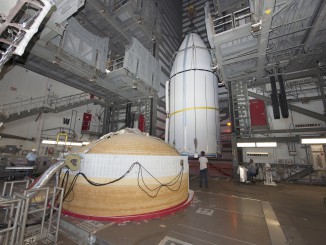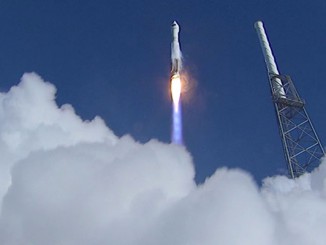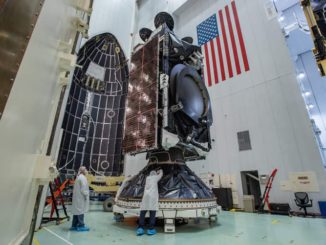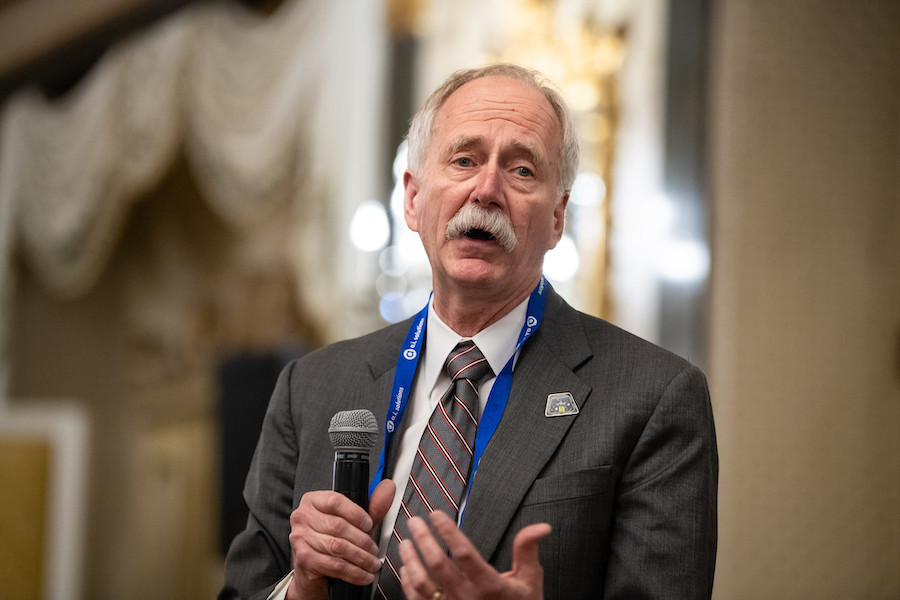
A senior NASA official said Tuesday that the Space Launch System, a huge heavy-lift rocket years behind schedule, could launch astronauts on a moon landing mission in 2024 on just its third flight to meet a goal announced last month by Vice President Mike Pence, while commercial companies will be entrusted with more responsibility to develop a lunar lander and a modest mini-space station, or Gateway, in lunar orbit.
The accelerated schedule, which would bring forward a moon landing from 2028 to 2024, is likely to require billions of dollars in additional funding per year, and new authority from lawmakers and the Trump administration, according to officials familiar with planning for a budget proposal NASA expects to soon send to Congress.
Bill Gerstenmaier, head of NASA’s human exploration and operations mission directorate, said Tuesday that the space agency is developing a “compelling presentation” for Congress with sufficient technical details on the 2024 moon landing plan to convince lawmakers to support the accelerated schedule, and the supplemental funding needed to make it happen.
“We’ll know in the next couple of weeks whether we’re successful or not,” Gerstenmaier said in a presentation to the National Academies of Sciences, Engineering and Medicine’s Space Studies Board.
Gerstenmaier’s presentation Tuesday offered more detail on NASA’s planning for a 2024 moon landing than the agency has previously disclosed.
“I will tell you it’s not easy, and it is not risk-free,” he added.
Before Vice President Pence’s March 26 speech announcing the Trump administration’s goal of landing humans on the moon by 2024, NASA’s schedule targeted a moon landing in 2028, allowing more time to build out a multi-module space complex in lunar orbit and a landing craft.
Assuming NASA can secure funding to pay for the accelerated moon program, there are numerous technical and schedule hurdles to overcome.
“We recognize that we’re going to be challenged, and we’re going to have to be prepared to back off some of these requirements in order to achieve schedule,” Gerstenmaier said. “That’s what we’re doing now to see which ones we can trade if we start running into some technical problems.”
“The biggest risk is schedule,” Gerstenmaier said, adding that Congress must approve a budget with the extra funding by the start of the next fiscal year in October.
“If we’re going to do this procurement stuff, I honestly need a budget come Oct. 1,” he said.
NASA Administrator Jim Bridenstine is scheduled to testify before a Senate appropriations subcommittee Wednesday afternoon, but it’s unclear if he will offer any new details on the budget required for the moon landing initiative.
“What happens when we go to 2024 is all the funding that was out there (for a 2028 lunar landing) … that now all moves forward,” Gerstenmaier said. “So you’re going to see a lot of budget move into 2020, 2021 and 2022 to allow for that first phase.”
“The first piece is we will have to get approval to move that significant amount of work forward,” he said. “That’s what we’re doing with now, is spending an inordinate amount of time building budgets, building plans.”
NASA officials have long said the new lunar landing program is not meant to be a redo of the Apollo missions, when six two-man crews reached the moon’s surface for stays lasting no more than three days. But the next landing, if achieved in 2024, would have to use existing satellite technology adapted for moon missions.
“I think you’re going to see a pretty minimalist kind of mission for that 2024 mission because of the constraints that we’ve got,” Gerstenmaier said.
NASA seeks commercial lunar lander options
The development of a lander may be the most pressing item needed to achieve the 2024 landing goal. Several companies are working on concepts for a human-rated lunar lander, but they have yet to progress to an advanced level of hardware testing.
On Friday, NASA released an updated a procurement notice to solicit integrated lunar lander proposals from industry. The update amended the original procurement notice, released April 8 in the wake of Pence’s speech, that outlined NASA’s plans to buy individual lander elements, such as a descent stage, ascent stage and a transfer vehicle.
NASA now plans to ask companies to design and build the entire lander, and launch pieces of the spacecraft on commercial rockets to be assembled at the Gateway in the vicinity of the moon, providing “essentially an all-in-one service for landing,” Gerstenmaier said. The ascent stage of the lander could be used on multiple landing missions, ferrying crews between the Gateway and the lunar surface.
“It looks like it reasonably fits, by pushing some of this work off to the private sector, rather than us doing all three pieces (of the lander), and then figuring out how to integrate those, this gives us some degrees of freedom,” Gerstenmaier said.
The quick change illustrates how quickly NASA officials are upending their previous lunar exploration plans after Pence’s announcement, in which he called for new urgency within NASA to land humans on the moon in 2024 “by any means necessary.”
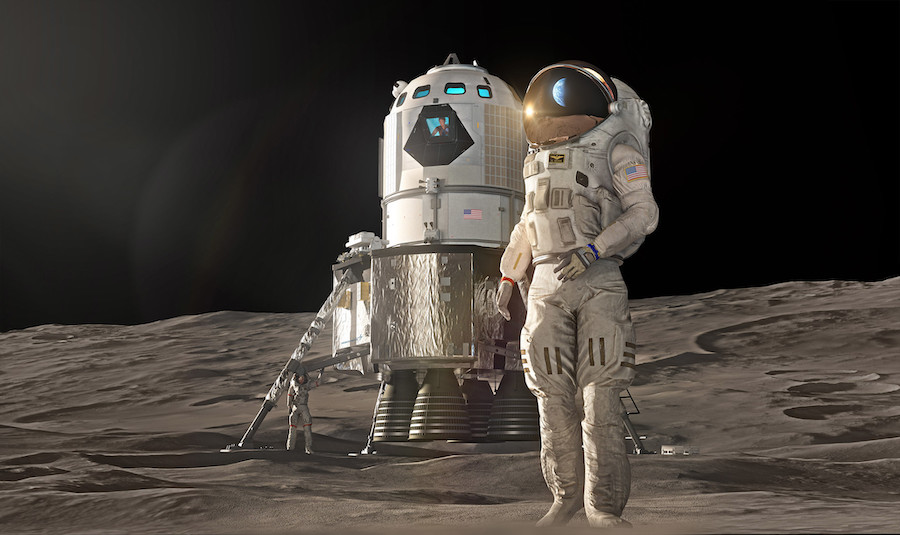
NASA announced partnerships last year with nine U.S. companies working on privately-developed robotic moon landers to carry experiments to the lunar surface. The agreements in the Commercial Lunar Payload Services, or CLPS, program are designed to foster technologies on smaller-scale, less risk-averse robotic missions that could feed into bigger spacecraft capable of landing with astronauts.
Gerstenmaier said NASA’s experience with the CLPS providers will inform the agency about the readiness of commercial companies to oversee development of a human-rated lander.
“If we find out industry is not really ready to even support 100 kilograms (220 pounds) to the surface of the moon because of maybe hazard avoidance and other things, then that gives us a clue about these bigger procurements for human systems, that maybe we’ve got to rework our strategy,” he said.
In his presentation Tuesday, Gerstenmaier did not discuss any plans for a test of a human-rated lander before the 2024 mission with astronauts.
In order to meet the 2024 schedule, Gerstenmaier repeatedly stressed NASA and its commercial partners will be forced to choose from technology that is available today, not technology that could lay the foundation for a more enduring lunar exploration program.
Instead of a more efficient cryogenic engine, the lander will have to use a throttleable hydrazine-fueled engine, similar to the propulsion system used on the Apollo lunar lander.
“Almost all this hardware that we’re going to use has to be available today,” Gerstenmaier said. “We don’t have a chance to go develop a new engine. Tanks are typically long-lead items. Those tanks are going to have to be available today.”
Avionics and life support systems designed for the Orion crew capsule could be applied to the moon lander, too.
Lockheed Martin, the Orion spacecraft’s lead contractor, unveiled a new human lander concept last month at the Space Symposium in Colorado Springs. Blue Origin, the space company founded by billionaire Jeff Bezos, has teased an announcement next week that is expected to involve a commercial moon lander.
“This urgency of 2024 is going to force us to take and select components moving forward,” Gerstenmaier said.
“But it’s not pretty,” he said. “There will not be a ton of time on the surface for this first flight.”
Lunar landing crew to launch on third SLS/Orion mission
In his March 26 speech, Pence said NASA should be willing to switch contractors if companies working on elements of the moon landing program underperform. Boeing is the prime contractor on the Space Launch System’s core stage, delays of which NASA has primarily blamed for a series of schedule slips that have pushed back the first SLS test launch from 2017 to late 2020 or early 2021.
The Space Launch System is designed to send Orion crew capsules into deep space, and Gerstenmaier said NASA’s new flight sequence would move up the crewed moon landing to occur on the third SLS/Orion mission, called Exploration Mission-3.
The first SLS/Orion flight, named Exploration Mission-1, will serve as a key test for NASA’s new rocket and a deep space demonstration for the Orion spacecraft in lunar orbit without astronauts on-board.
“We’re probably looking at, best case, probably a late 2020 kind of launch, but probably more likely some time in 2021 (for EM-1),” Gerstenmaier said Tuesday.
Delays in outfitting the SLS core stage’s engine section have been responsible for the rocket’s recent delays. The SLS team in March said the issues were likely to push back the EM-1 launch to 2021, prompting Bridenstine, NASA’s administrator, to order a review of options to launch the Orion spacecraft around the moon in 2020 on a commercial booster.
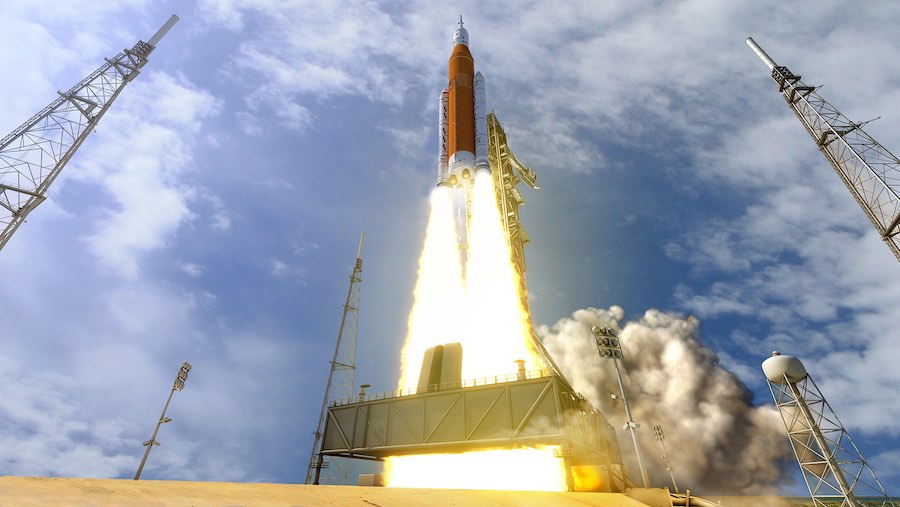
Engineers identified an option that could couple parts of SpaceX’s Falcon Heavy and United Launch Alliance’s Delta 4-Heavy rockets to lift the Orion capsule to the moon, but Bridenstine said the difficult work to design and develop the new rocket stack would take longer to complete than the Space Launch System.
NASA and Boeing teams have reworked the SLS core stage production schedule to complete some assembly of the 27.6-foot-diameter (8.4-meter), 212-foot-tall (65-meter) rocket structure in parallel, instead of sidelining some of the integration tasks until the engine section is ready.
“The big rocket is coming together fairly well,” Gerstenmaier said. “The thing that’s been problematic to us is the engine section. That’s the section down at the very bottom of the rocket.”
This is all the plumbing and wiring and feed-throughs, the big ducts that come from the hydrogen tank, that come from two big oxygen feed lines … They all go through these big feed likes to feed these engines,” he said.
Four hydrogen-fueled RS-25 engines will power the SLS core stage. The engines are left over from the space shuttle program.
The cramped conditions inside the engine section have proved a challenge for workers.
“Just getting physically inside for the workers … to be in there has slowed down the process in that work,” Gerstenmaier said. “There’s nothing that’s fundamentally wrong. It’s just that I think we misinterpreted how long its going to take to do this work, and the other problem is it’s first-time work.”
Gerstenmaier said the replanned schedule saves three-and-a-half months of time.
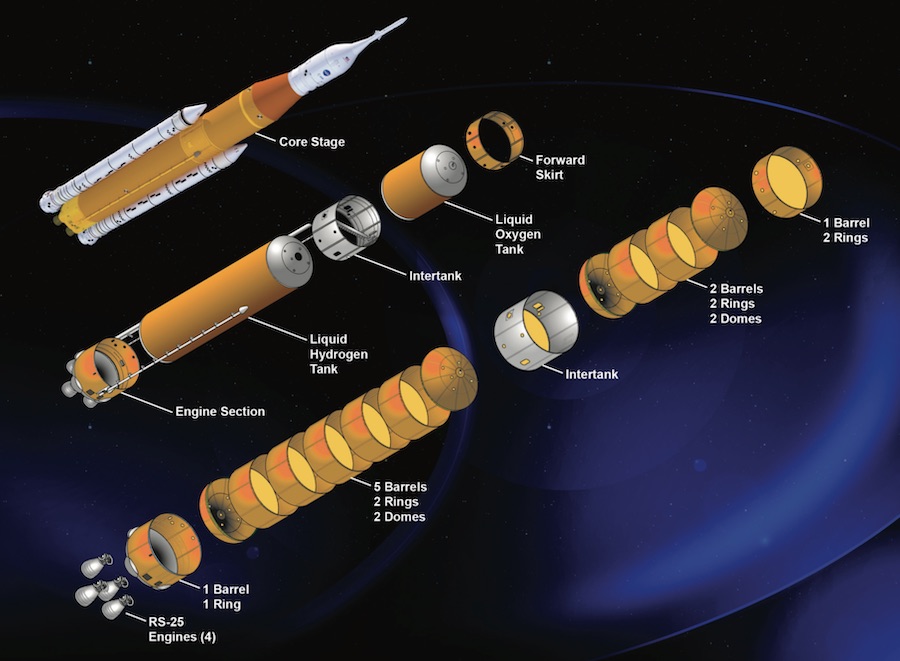
Boeing previously planned to connect the core stage’s liquid hydrogen tank to engine section vertically, then rotate the assembly horizontally to connect to the intertank, which is already mated with the core stage liquid oxygen tank.
The new plan will see the hydrogen tank horizontally integrated with the intertank and liquid oxygen tank first in the coming weeks at the Michoud Assembly Facility in New Orleans. Once the engine section is ready, it will be installed horizontally to the base of the core stage, instead of in a vertical orientation.
The factory’s roof is not high enough to assemble the entire core stage vertically.
“We talked about knocking a hole in the assembly building,” Gerstenmaier joked. “That motivated some creative thought on our teams’ part when we suggested that … When you’re faced with a problem, you give them a ridiculous solution that’s so bad that normal human begins cringe at.”
Later this year, workers will add the four RS-25 engines, which have completed qualification testing at higher thrust levels than they saw on space shuttle missions.
Gerstenmaier said the core stage should be completed by the end of this year in preparation for shipment via barge to the Stennis Space Center in Mississippi for a full-duration eight-minute firing of the four RS-25 engines on a test stand.
NASA has considered cancelling the “green run” test at Stennis to save time.
“We’re looking at either deferring the green run or expediting the green run to look and see if we can save some time,” Gerstenmaier said Tuesday.
But the green run test is the only chance for engineers to assess how the core stage will perform through an entire launch sequence, with the engines throttling to different power settings and a checkout of the rocket’s pressurization system.
“We could do a shorter duration firing at Florida (on the launch pad) if you wanted to, but then you get a six-second, 10-second kind of firing,” Gerstenmaier said. “We’d like to run a little bit longer to actually go through the thrust profile.”
Once in Florida, the core stage will be attached to two solid rocket boosters, a cryogenic upper stage derived from ULA’s Delta 4 rocket and the Orion spacecraft.
The Lockheed Martin-built crew module and the European-built service module for the EM-1 mission are being readied for launch inside a clean room at the Kennedy Space Center. The Orion sections will be mated this summer before going to a NASA test site in Ohio for testing in the cold, airless environment of space.
If that testing goes according to plan, the Orion spacecraft should be ready to begin its launch campaign in early 2020, but the start of final flight preps will wait until the SLS is delivered to KSC.
Gerstenmaier said the first SLS/Orion flight with astronauts, designated EM-2, could take off in 2022 on a “free return trajectory” around the moon and back to Earth.
Meanwhile, the power and propulsion module and an austere habitat would launch on commercial rockets to dock in lunar orbit to form the Gateway. Elements of the lander would arrive at the Gateway after commercial launches in time for a 2024 landing.
“Then the third (SLS/Orion) flight, you go to Gateway, you meet up with some lander elements, and then you can support a 2024 landing,” Gerstenmaier said.
Outline emerges for more modest Gateway
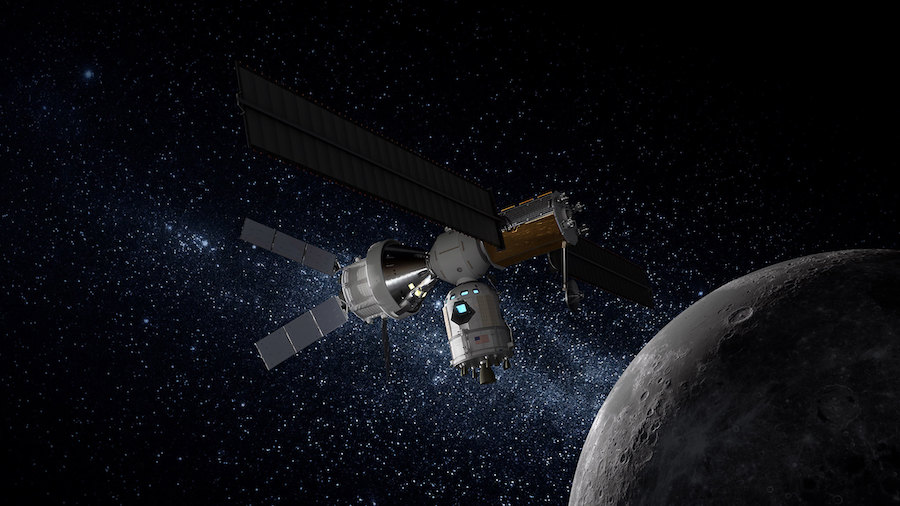
The new urgency triggered by Vice President Pence in March has raised questions about the utility of the Gateway, the mini-space station NASA originally aimed to build in lunar orbit before mounting a landing expedition.
The Gateway is still a critical piece of NASA’s plans, Gerstenmaier said, but the agency’s focus now is to launch the first two pieces of the outpost by 2023 to ensure the Gateway can act as a safe haven and staging point for a moon landing mission.
Under the plan outlined Tuesday, a Canadian-built robotic arm, an airlock and refueling module provided by the European Space Agency, and other segments of the Gateway would be deferred after the 2024 moon landing.
There is no commercial rocket currently in service that could launch all the pieces of a lunar lander in one flight, according to Gerstenmaier. That means the lander will be assembled at the Gateway.
NASA is already well along in the procurement of the first Gateway module, called the Power and Propulsion Element, or PPE. The module will have plasma thrusters, a propulsion system using xenon fuel and solar power to maneuver between different orbits around the moon more efficiently than with conventional rocket propellants.
Multiple companies have submitted bids to build the PPE, and Gerstenmaier said NASA is on track to select a contractor for the module this summer. The Gateway’s core module was initially expected to launch on an SLS flight, but NASA asked proposers interested in building the PPE to arrange to launch the spacecraft on a commercial heavy-lift rocket.
The winner of the PPE contract, which is framed as a commercial procurement, will deliver the module to NASA in space.
“The Power and Propulsion Element would in orbit around the moon in December of 2022,” Gerstenmaier said.
That will be followed by another Gateway module that doubles as basic living quarters for astronauts and a docking connector for a lunar lander. Five companies have developed habitat module prototypes for ground testing, and Gerstenmaier said NASA aims to select a commercial builder for the Gateway’s habitat module by December, in time for a launch — also on a commercial rocket — in 2023.
“It fits on paper,” Gerstenmaier said. “The challenge will be to industry.”
Email the author.
Follow Stephen Clark on Twitter: @StephenClark1.

